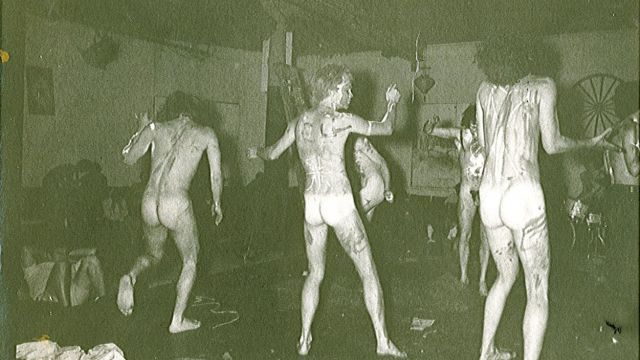Before The Fringe
Australian experimental theatre in the 60s was stripped bare.
by Clem Gorman.
Before there was a Fringe, hovering on the edges of the established theatre, in Sydney there was a bold, sometimes naive, but always exciting strand of live performance, running its own race outside the Establishment, called Experimental Theatre.
Nothing comes from nothing, as Lear would say, and there were forerunners to the experimental groups that were started in the late 60s. One of these was Sydney University Drama Society – SUDS, where eager young know-it-alls directed several avant-garde plays including Genet’s Deathwatch and several Brechts. University Revues, too, featured several sketches which owed a great deal to Ionescu, Pinter, Albee and Beckett. However, when the experimental work got under way from 1967, we looked not to foreign models but to ourselves.
Producers and Actors Co-Operative Trust – P.A.C.T. – was an organization, started by Robert Allnutt and others in 1965 in an old woolstore beside Darling Harbor. It promoted innovative theatre, singer/songwriter evenings, and playreadings. I was on the committee, along with none other than the Wild One, Johnny O’Keefe. The whole point of experiment is risk-taking, and sometimes the experiment ended in dire failure. But, sometimes, performance work of dazzling clarity, provocative freshness and rich innovation emerged.
The Human Body.
The prime movers were Johnny Allen, Judy Gemes, and myself; then an ambitious writer/director with a headful of ideas. The three of us got together in 1967 to create The Human Body, Australia’s first experimental theatre group. They were deeply influenced by Grotowski and Artaud, while I was more moved by the New York group The Living Theater. We all agreed, however, that we wanted a performance that opened out to the audience – no fourth wall – and that involved risk taking.
Ceremonies, conceived and directed by myself, opened at PACT Theatre in 1968. The central idea was a feast to which the audience brought food to be shared, and our group staged little entr’acts among them. Katharine Brisbane, then reviewing theatre for The Australian, was highly complimentary, though she held back from participating. On the last night all of the group danced naked, painting each others’ bodies. The police were called, and the night ended with certain actors discreetly absenting themselves from the premises via a back door.
Later the Body staged Juno’s performance The Human Body Eats a Peach, featuring an installation of plastic pipes and tunnels and an attempt to stir the audience by confrontation.
Our final show was Laughing Blues Mass, a semi-spiritual event at the Paddington Town Hall where the group, helped by Albie Thoms’ UBU Films and the Foreday Riders Blues Band, mixed the excitement and chaos of a hippy Happening with a performance by our group.
Happenings.
At this time I was also staging Happenings, co-ordinating a loose alliance of performers. The first was The Explosion Factory at the Cellblock Theatre in Darlinghurst, 1968. Here, the audience were the performers, dancing, gazing at lightshows, tripping, stripping, laughing and generally losing control.
Another collaboration, was Tibetan Environment at the Cellblock, a quiet meditative evening featuring Tibetan music and a lightshow.
The Australian Arts Lab.
In Paddington, the Arts Lab featured playreadings, assisted by playwright Alex Buzo and including plays by Jack Hibberd and John Romeril. Buzo’s iconic play Norm and Ahmed received its first public airing there. There were also experimental films and poetry readings.
Australian Free Theatre Troupe.
This group, with myself as co-ordinator, and funded by the new Australian Council for the Arts, created work from own untrammelled imaginations. The Birth of Space, staged at Wentworth Hall, Sydney University, and toured to la Mama in Melbourne, was first. Grahame Blundell and Kerry Dwyer performed at La Mama, and we received some good notices. The story was an Australian version of a Hindu play about the eternal struggle between good and evil. It was very physical for the audience, if only because the actors trampled all over them.
We also staged Trance Dance, with the Nutwood Rug Band, based on the idea that if you dance for long enough you may somehow achieve a kind of ecstasies. (No, no illegal substances).
Book of Ceremony.
Based on our work, Sandy Gorman published a Book of Ceremony which we jointly wrote. The theory was that everything in life is a form of ceremony: not necessarily formal, but stemming from an unconscious conspiracy of all people that relationships are, in their essence, ceremonial.
Ceremony Productions.
Living Poetry, at PACT, co-produced by myself and John Tranter, featured a number of Sydney poets reading, with a lightshow, rock band, strobe, and a little nudity, when artist Gordon Mutch body-painted a very beautiful young woman. The media focussed on the young woman: “Redhead in the See-Through”.
Legacy.
The legacy is the Fringe. Sydney’s Performance Space for years was a centre for experimental performance work, usually based upon foreign inspirations. In London during the 1970s I staged a number of performance art events, one in a Covent Garden art gallery, one in a Chelsea wine bar. In this country, contrary to what many may assume, much of the alternative was home grown. Cut off from the world as we were, we simply plunged in and ... just did it.
Originally published in the May / Jne 2010 edition of Stage Whispers.
Clem Gorman's plays are available for performance.
For details go to www.davidspicer.com.au/author/clem-gorman
Titles include. The Last Night Club, A Fortunate Life, A Manual of Trench Warfare and A Night in the Arms of Raelene

